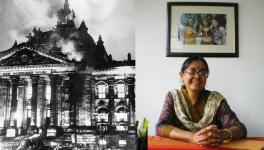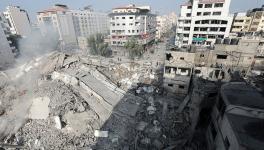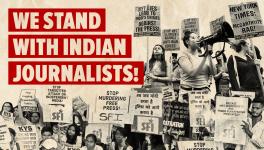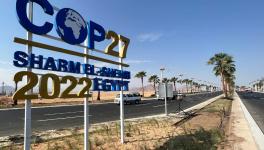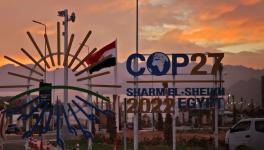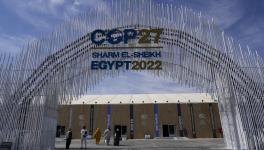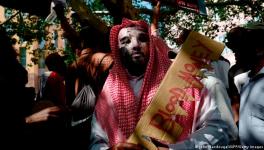Mubarak gets the Boot: Tectonic Changes in the Arab World
72
1024x768
Mubarak did not really leave his Presidency willingly – he had to be dragged out, kicking and screaming. What he could have got away with in the beginning -- handing over power to Suleiman and negotiations -- was not enough in the end. There is little doubt that with mass strikes in most of Egypt and the pressure created by the ongoing protests, the Army has finally told Mubarak enough is enough.
The West, particularly the US, was not happy about this turn of events. However, saving the regime was important to them, Mubarak was expendable. Faced with mass protests, on a scale that has not been seen for the last 40 years in the Arab world, retaining, at least, the core institution of the regime – the Military – guided the US actions. The key for them is how to manage the transition now; without giving up the geo-strategic dominance that the US has in the Middle East. If the Egyptian revolution furthers the cause of Arab nationalism and is seen as a call for an independent foreign and economic policy, US interests would be deeply threatened. As would, the security of Israel, which has banked on Egypt being a tacit ally.
I have been to Egypt a number of times, the last time, only a few months back, to try and break the blockade of Gaza at the call of Code Pink. Of course the Mubarak regime, very much a partner of Israel in this blockade, stopped us from going to Gaza. One could feel the anger of the people against the Mubarak regime and the sense of humiliation they felt- with Egypt being seen as a lackey of the US. What prevented the outburst of this anger was the fear of the powerful security establishment that Mubarak had built up over the last 30 years. It is this fear that broke over the last 18 days.
I was in Dakar for the World Social Forum and met a number of activists from Egypt. Mamdou Habashi, an engineer and an activist for workers and civil rights, explained to a group of us the background of the mass movement in Egypt.
Mamdouh described the challenge of the movement – it has been without visible heads, now it has to “grow” these heads. Egypt, till now, only had a formal democracy– a democracy in name, but in reality, a controlled democracy, where even the “opposition” parties were a part of the regime. There were formally three platforms – Left, Right and Centre -- first within the Nasserite formation of the National Democratic Party (NDP), later the Left and Right leaving the NDP and forming their “independent” parties. Elections and other institutions of democracy were not more than a charade. Every election conducted was through fraud, the last one being so blatant that in the second stage of the elections, Mubarak was forced to rig for some of the official opposition parties, so they would have at least 5% seats in the Parliament!
Mamdouh remarked on the irony that 25th of January had been promulgated as a Police Day: a day on which the police were to be “honoured” across the entire country. Instead, that day became the start of the protests against the Police State that Mubarak had built.
Who were the actors who started the protests? The two major youth groups were the “Kolona Khaled Saeed” (We are all Khaled Saeed) and the 6th April Youth Movement. Each of them had built a large following using Facebook and Twitter. In addition, the 6th April Youth Movement were also closely connected to trade union activists, particularly in the state run textile factories in Mahalla, located just north of Cairo. The core activists met a number of times to work out the entire plan – how the protests would be organised, how the groups would be formed and how only a few would know the actual routes and destinations. This is how the Day of Rage – 25th January -- was organised and protests sustained in Tahrir square and other parts of Egypt over the next 18 days. Once the program of protests was announced, cutting Internet and mobile networks did not matter. Everybody knew the essential details -- dates, routes and where they had to protest.
It is important to understand the nature of the Security Apparatus that Mubarak had built up and why protests were so difficult in Egypt. Egypt has one of the highest police to population ratios in the world – 1.2 million police. In addition, it has a 350,000 strong Central Security Force, whose primary task is to break up strikes and protests. The Mubarak regime had calculated that they could control demonstrations of up to 70,000. Their problem started when the numbers exceeded this and also due to the protests taking place in multiple, widespread areas. For the first few days, they tried hard to crush the protests. They battled the protests on the streets of Cairo, called up their entire reserves and also used the plain clothes police Intelligence – the Mukhabarat – to beat up and kidnap protesters. After 5 days of street battles, they were completely beaten. As one of their officers explained to Al Jazeera, “... after 5 days of round the clock street battles, our forces were completely exhausted and simply collapsed”. What had worked for 40 years – crush any protest physically, failed this time, because the Egyptian people came out in such large numberI
In the initial phase, while the police were battling the people, the Mubarak regime did not believe that the protests could be sustained. They had told the world and themselves that Egypt was not Tunisia and the Egyptian state was far more sophisticated in handling dissent. After failing to crush the resistance, their next attempt was to split the people – they claimed it was the Muslim Brotherhood causing the dissension. Mamdouh said that the people laughed – they knew very well that Muslim Brotherhood had opposed the general strike called in sympathy of the textile workers in 2008 and was not a part of the 25th Day of Rage call as well. The only ones who believed these claims were the Western Governments and the international media.
Failing to split the people and with the Muslim Brotherhood joining the protests on the 4th day of the protests, the next tactic was to try and make it seem as if the only choice was between Mubarak and anarchy. The prisons were opened; the police and criminal gangs were let loose. They looted shops, burnt down offices and tried to create anarchy. The peoples’ response was equally swift; within a day they organised themselves into Civil Defence Groups. Mamdouh told us that not only this stopped the looters, but they also provided a vehicle for popular mobilisation. People – rich and poor, young and old, men and women - came together.
The next attempt by the regime was visible to all – Mubarak’s goon squads, mostly police and Mukhabarat, in plain clothes, using Molotov cocktails, sniper rifles and camels and horses against protestors at Tahrir square. This was the defining moment – the protesters stayed put and the regime failed to clear the Tahrir square, leaving them with few options. They could not use the army against the protesters, as that would have meant that the final legitimacy of the Egyptian state would also be lost. And there was a good possibility that the military would itself splinter if such an order were given. The Armed Forces in Egypt are based on compulsory services of 3 years; it is a conscript army and its’ sympathies with the protesters was visible.
Once the Mubarak regime’s ploy of physically trying to clear Tahrir square failed, it became an issue of how soon Mubarak would go. He had already agreed not to stand for re-elections in September – a promise which, for the protesters, was not soon enough. However, this did help prompt the regime to try and hold talks with some of the “official” opposition parties. Interestingly enough, while the Youth Movements -- who were clearly leading the protests -- rejected the call for talks, as long as Mubarak remained, the Muslim Brotherhood joined in the negotiations. Mamdouh made clear his belief – the top echelons of the Brothers have also been co-opted by the regime. Which is why they not only opposed earlier protests and calls for strikes but also supported, in the Parliament, all the retrogressive measures proposed by the Mubarak regime.
After the clashes of 2nd February, some of the participation had reduced. However, the lull was only temporary. The crowds built up again and now spread from Cairo, Alexandria and Suez to all parts of the country. Mubarak’s last ploy – handing over power to Suleiman also failed. The anger of the people was palpable. This was the critical moment for the Military – either to send Mubarak packing or fire on the protesters as they marched to the Presidential palace. Labour strikes had started all over the country, swelling the ranks of the protesters. As the protests started moving towards the Presidential palace in Heliopolis, where Mubarak was believed to be, the news arrived that he had left for Sharam el Sheikh, where he has a private palace. Soon after, the Armed Forces announced that Mubarak had resigned and handed power to the Supreme Council of the Armed Forces. Effectively, the Supreme Council had now assumed the Presidency.
As I am writing, the Supreme Council has met some of the other demands of the protesters – they have dissolved the Parliament created through fraud elections last year, suspended the Constitution and also agreed to set up a committee for drafting Constitutional amendments. They have also assured the people that they will hold elections and hand over power to a civilian Government within six months. What they have yet to do is to lift the Emergency, which has been in place in Egypt since 1981. They have also not created a transitional Government with Military and well-known figures from civil society or the upper judiciary as the protesters have been demanding. The Armed Forces are continuing with an interim arrangement, packed with Mubarak’s men.
While the battle for the democratic content of the revolution would continue, the key now is to use the transition period to create genuine political parties with coherent agenda. In place of the fake parties that exist now, the political process has to start creating genuine political formations based on certain ideological beliefs. This is not going to be easy in a country that has seen complete suppression of all political processes under Mubarak. The second part of the transition phase would be meeting the immediate demands of the people. This is responding to the core economic demands that were raised during the protests.
Mamdouh drew our attention to the core demands of the movement– formulated by the coalition called “The Revolution's Youth”. Groups involved include the 6th April Youth movement, Justice and Freedom, Muslim Brotherhood youth, ElBaradei's campaign, The Popular Democratic Movement for Change (HASHD), The Democratic Front and Khaled Saeed Facebook group administrators. The demands indicated the close relations the movement had with the workers movement. Juan Cole, a well-known analyst of the region, identified the drivers of the movement in Egypt and Tunisia as the labour movement.
To many, the Muslim Brotherhood is seen to be a danger that Egyptian revolution could go the Iranian way. This was the constant refrain that BBC and CNN were singing. What they did not state is that the US has always preferred Islamic forces to nationalist ones. The Muslim Brotherhood for the US is a conservative force, fully in tune with its neo-liberal economics and therefore can be co-opted into the regime. They are also fully aware that the Brothers are no longer the force they were earlier and as members of the Parliament, had fully co-operated with the Mubarak regime. It is the Youth and the Women's sections of the Brotherhood that had joined in the protests, the conservative upper echelons being dragged unwillingly and ever ready to negotiate with the regime.
Even though secular and democratic forces have driven the Egyptian and the Tunisian revolutions, there is always the danger of it being hijacked by the more organised Brotherhood. There is also the danger of the remnants of the NDP becoming a force through some cosmetic changes – they still occupy various positions of power in the Egyptian state. Finally, there is the Military – no longer the nationalist force it was under Nasser, compromised with its close links with the US and the Mubarak regime, but still looked upon with some respect by the people. Whether the Military will limit itself only to its sphere and lets the civilian and judicial side function independently, remains to be seen.
The other issue that will loom over Egypt and the region is the relationship with Israel. It is not whether the peace treaty with Israel will be observed or not. The real questions are whether the Gaza blockade will continue and whether Egypt will continue to back Israel on the larger Palestinian question. Egypt can no longer be run as a personal fiefdom of Mubarak – the people’s consent will be important on strategic issues as well. The geo-strategic balance in this region has changed dramatically and this will have its impact everywhere. The simple consequence is that Israel and the western world can no longer take Egypt for granted.
Egypt’s political future is not clear. What is clear is that political space has opened up in Egypt and in the region. Given that this region is setting the global agenda, this has enormous implications for the rest of the world. Hopefully, the pre-occupation of the world will shift from the Islamophobia spread by the US and its allies, to concerns of democracy, equity and economics. Maybe we will be able to focus on the civilisational crisis facing the globe today – from economics to climate change. This is the hope that Egypt and Tunisia has kindled.
Get the latest reports & analysis with people's perspective on Protests, movements & deep analytical videos, discussions of the current affairs in your Telegram app. Subscribe to NewsClick's Telegram channel & get Real-Time updates on stories, as they get published on our website.









